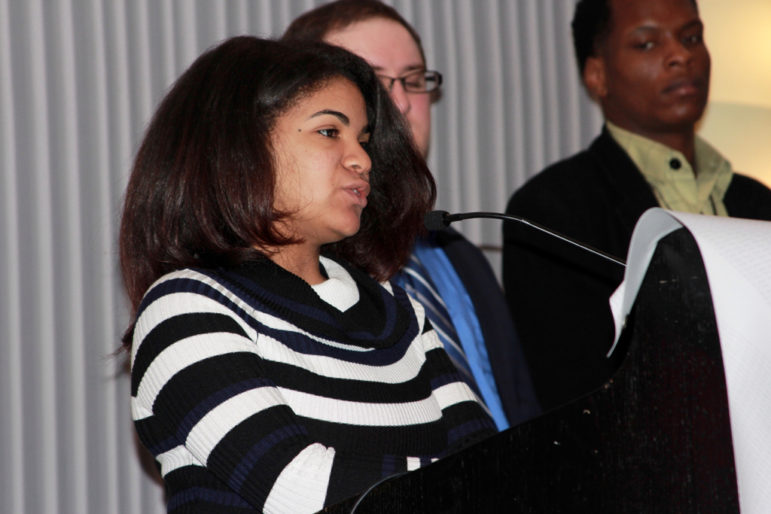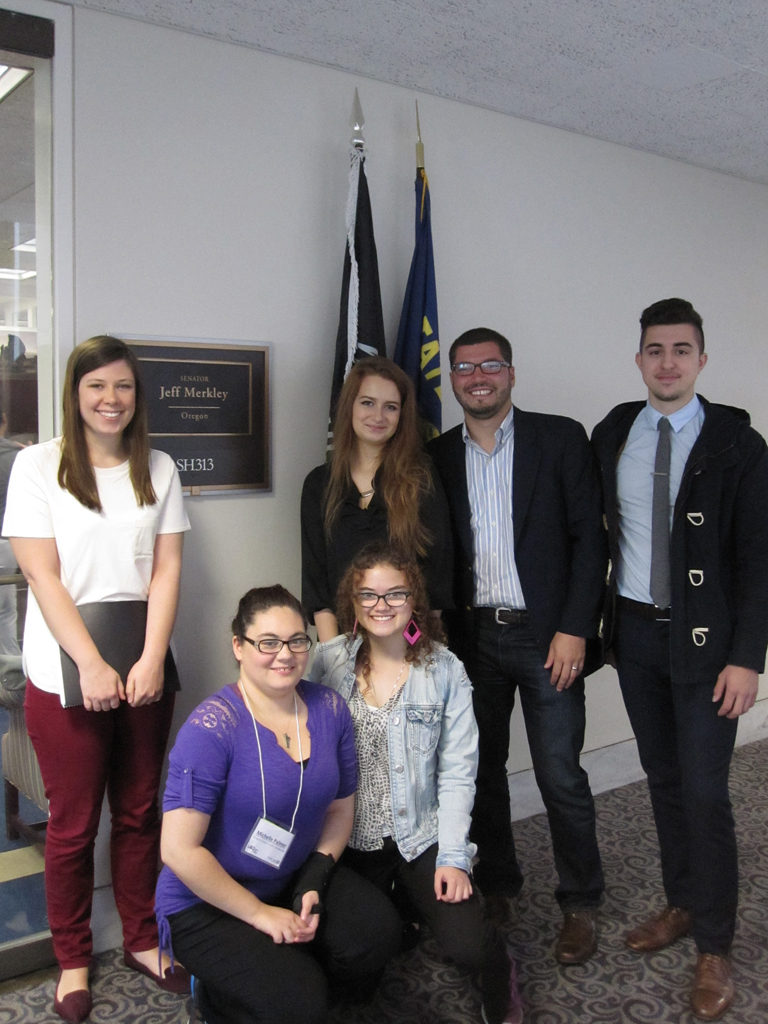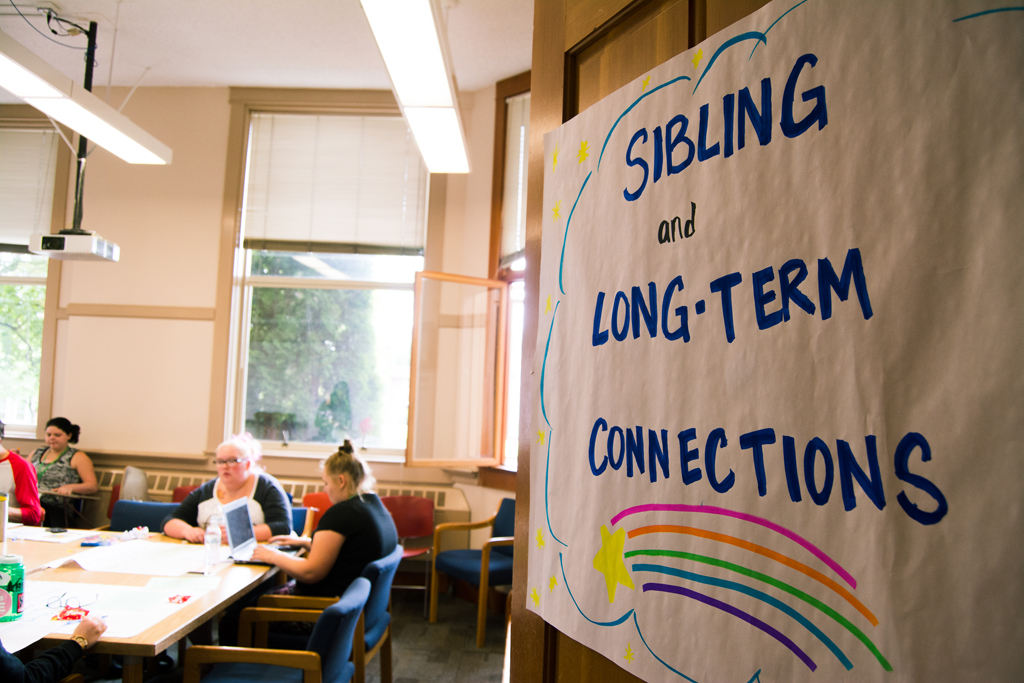Chelsea Bramblett didn’t know what to expect the first time she showed up at the statehouse in Tallahassee, where the advocacy group Florida Youth SHINE gathers each year to make their case for improvements to the state’s child welfare system.
She was hesitant, skeptical that anyone would take the voices of foster youth like her seriously. Bramblett, who had entered care with her sister at age 15 just a few years before, worried that the stigma of foster care would leave her feeling judged by the powerful people she was supposed to convince, not empowered.
But the dedication and power of the Youth SHINE members she met made her think things could be different. She liked that their lobbying efforts were rooted in their own experiences — and that lawmakers were taking notice of what current and former foster youth had to say in testimony about policies they wanted to change.
As they shared their stories, Bramblett, now 22, heard echoes of her own journey through the child welfare system. It made her feel she had found a home, one where people would love and encourage her.
“Even though we were complete strangers, or most of us were, it was like walking into a family,” she said. And that family keeps getting bigger.
A national network for voice
Florida Youth SHINE now is one of nearly 20 members of Foster Youth in Action, a national network of state foster youth advocacy organizations dedicated to elevating youth voices to make policy changes at the local, state and federal level.
Youth-led advocacy can be messy work, the members say: Youth who often have had little say over their lives have to feel comfortable and in control, youth and adult allies often have lots to learn about advocacy, and making legislative or regulatory change demands a lot of any grassroots group. But the members say it’s worth it, and that Foster Youth in Action is making their work easier.
Because of the network, when foster youth want to know more about how to craft a bill, or what legislative language worked to win over lawmakers, they have hundreds of people they can consult.
Just three years ago, in 2014, the network had six members. By December of 2016, 17 groups had joined. Collectively, the members have successfully advocated for 70 laws or policy changes across the country.
Among their victories, youth have pressed successfully for legislation that allows youth in the child welfare system to participate in extracurricular and social activities without jumping through hoops in Florida. They’ve won support for financial literacy programs and an ombudsman’s office in Oregon. And in California, they’ve helped pass legislation that allows siblings in the child welfare system to maintain close ties to one another.
Joshua Ashbaugh, 20, a member of Oregon Foster Youth Connection, said he jumped full-speed into the group several years ago, immediately signing up to work on a legislative action team. He liked the bustle of advocacy work — coming up with an agenda, visiting lawmakers and testifying about legislation — as well as the feeling of pride when bills that mattered to him were sent to the governor’s desk.
This year though, when he attended one of OFYC’s conferences, he settled into a different role: acting as an advisor for younger members who needed help navigating the group. He’s glad he’s been able to find different niches within the group as his own life changed.
“You grow through the experience, and it’s all for the greater cause. You see that and it makes you feel very hopeful,” Ashbaugh said.
The organizations’ adult allies also seek advice from one another as they work behind the scenes to keep activities running smoothly. In personal or group emails and phone calls, as well as in person at FYA’s conferences, they may ask for broad perspectives about how to keep youth voices at the forefront of everything they do or the nitty-gritty details of how to start a local advisory board.
“You throw out a question and you have all these people with different perspectives who are there to help you,” said Lisa McMahon, program director at Oregon Foster Youth Connection.

Allen Fennewald
.
Offering tools
The network offers its members technical assistance as they build organizations, training on how to promote youth voice, and opportunities for youth and adult allies to make their voices heard at the U.S. Capitol.
The members want to learn how to elevate youth voices, grow the number of
participants in their groups and understand state and federal policies.
They also may be dealing with problems such as pushback from child welfare systems that fear youth will point out more problems for already overwhelmed systems to fix; staff members who are trained to be social workers not political organizers, and a lack of independent funding, said Matt Rosen, executive director of the network.
Foster Youth in Action will share curriculums and answer questions, as well as jump right into the work alongside state leaders.
Rosen recalled working in a state where youth workers and foster youth wanted to launch a youth-led program. FYA helped bring the state’s child welfare agency to the table as well, so that they could see the positive potential of a youth-led movement, rather than only the threat. They got to see up close why the process of youth deliberation and action mattered.
“We’re providing the things that people want and need. There’s a hunger for the tools, approaches, materials, success stories and opportunities,” he said.
Rosen said foster youth-led successes in California, Iowa and Florida have helped put the spotlight on the potential of the groups, as has a more general interest in the value of youth voice across all sectors.
The key now for the foster youth field is to make sure the technical knowledge is there about how to run a group, ensure young people have positive experiences, and approach lawmakers, Rosen said.
How to build foster youth voice
One lesson groups must learn is how to let youth take the lead, on everything from choosing policies they want to change and designing materials to leading workshops and speaking to lawmakers.
That’s not always easy, said Rosen and other adult allies from across the country. It requires technical know-how, as well as a deep commitment from staff to the principle of youth voice.
Carmelita Coleman, executive director of SaySo, a foster youth-led group that works throughout North Carolina, says the group takes “nothing about us without us” as its mantra and constantly evaluates whether their policies are keeping youth front and center.
That means youth run their board of directors, design programs and host meetings. Adults often are wary when they’re introduced to the concept, but “just because they’re nervous doesn’t mean it doesn’t work,” she said.
And when groups struggle with how to strike a balance between youth-led and adult-supported efforts, the network offers resources on writing agendas, retention and recruitment, coaching and debriefing.
In addition, McMahon, in Oregon, said supportive adults have to remember that youth have many demands on their time and are often dealing with disruptive transitions in their homes and schools. Their participation in the group may ebb and flow, but they need to know they’re always welcome back in.
Similarly, young people need different ways to get involved, McMahon added. Some might be ready to testify before a committee, while others would rather take a survey or work behind the scenes to ease themselves into the process.
Group members and leaders throughout the country also stressed the importance of incorporating training for youth about how to tell their stories to policymakers because the experience requires such a delicate balance of vulnerability and resilience.
Bramblett, at Florida Youth SHINE, said that from the beginning, she was impressed the group was there to give her the support she needed to tell her personal story based on her comfort level. She decided how much she wanted to share and with whom.
Once she knew those parameters, she was able to think through how to talk to policymakers. Even now, after speaking frequently with lawmakers, she will rehearse what she wants to say and write a brief outline, so she doesn’t end up sharing more than she wants to.

Photo courtesy of Oregon Foster Youth Connection
Members of Oregon Foster Youth Connection met with staff from Sen. Jeff Merkley’s, D-Oregon, office during the 2016 Foster Youth in Action conference in Washington, District of Columbia.
Without talking all those steps, youth can get caught off guard, she said. She knows other young people who have felt obligated to answer a question or address a topic they weren’t comfortable with when they lacked sufficient training.
Rosen said most groups take an approach like Youth SHINE, first stressing the importance of comfort and safety, then moving on to how a story can be used most effectively in the advocacy area, a concept known as “strategic sharing.”
At its best, learning to share an experience and then using that experience to make change can help young people heal from past traumas, Rosen said.
“They can reap enormous benefits professionally, personally, developmentally by coming together with their peers,” he said.
What’s next?
The next step for the network is to collect more data about how the foster youth-led model works best, to help ensure groups are as effective as possible.
The members also are looking for ways to keep alumni involved in their efforts, including for their perspective on what they needed to age out of foster care, launch independent lives and maintain their successes.
Rosen said he’s most excited to see how the network grows and how foster youth can continue to change the conversation and policy about the foster care system by putting their experiences and perspectives front and center.
Bramblett, who is studying to be a social worker, said what she has learned as an advocate inspires her not just personally but professionally. She knows what she will tell young people she encounters in the future: “They’re the experts. Not everyone understands foster care. Share your experiences, your stories. It can make a difference.”






























